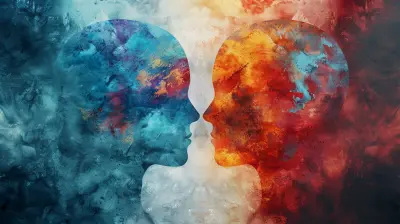How Cognitive Behavioral Therapy Can Help You Find More Joy
23 June 2025
Do you ever feel like your thoughts are just stuck in a loop—constantly dragging you down, feeding self-doubt, or making even small joys hard to recognize? You’re definitely not alone. Life's challenges, big or small, can drain our mental batteries. But there’s a surprisingly practical approach that can help you flip your inner script and invite more joy into your everyday life—Cognitive Behavioral Therapy, or CBT.
Let’s chat about how this powerful tool can actually help you build a more joyful, fulfilled life—one small mindset shift at a time.
What Exactly Is Cognitive Behavioral Therapy?
Okay, so first things first—what is CBT? In a nutshell, Cognitive Behavioral Therapy is a type of talk therapy that helps people change unhelpful or negative thought patterns and behaviors.It’s based on a super simple (but powerful) idea: our thoughts, feelings, and behaviors are all connected. If you change your thoughts, you can change how you feel and act.
Think of it like a mental GPS. When you keep taking the wrong route (negative thoughts), CBT helps you reroute toward a healthier, happier path. Instead of spiraling into “I’ll never be good enough,” CBT helps you reframe that into something more realistic, like “I made a mistake, but I can learn from it.”
Why Joy Feels So Out of Reach Sometimes
Let’s be real: joy feels like a rare gem some days. You wake up tired, stress greets you like an overly clingy friend, and social media keeps shouting that everyone else is thriving. It's a buzzkill. But here’s the thing—often, it’s not the events themselves that steal our joy, but our thoughts about them.Maybe you...
- Dwell on worst-case scenarios
- Automatically assume people are judging you
- Set impossible standards for yourself
- Struggle to feel “enough” no matter what you achieve
Sound familiar? These kinds of thought patterns, called cognitive distortions, can slowly erode your happiness without you even realizing it.
Common Cognitive Distortions That Kill Joy
Let’s break down a few common mental traps that CBT helps address. Recognizing these is a big first step toward change.1. All-or-Nothing Thinking
You view everything in extremes. It’s either a total win or a complete failure. For example, “If I don’t do everything perfectly, I’m a failure.” Ouch, right?2. Overgeneralization
One bad experience becomes your forever reality. Like, “I failed once, so I’ll always fail.”3. Mental Filtering
You zero in on the negative and ignore the good. Even if 9 things go right, your brain obsesses over the one that didn’t.4. Catastrophizing
You imagine the worst-case scenario automatically. That headache? Probably a brain tumor. Someone didn’t text back? They hate you now.5. Personalization
You blame yourself for things outside your control. Your friend is upset? It must be something you did.CBT helps you call out these patterns and replace them with healthier, more balanced thinking.
Rewiring Your Brain for Joy with CBT
Now that we know what’s getting in the way, how does CBT actually help you find more joy? Let's get into the good stuff.1. Building Awareness
The first step in CBT is becoming more aware of your thoughts. This might sound simple, but it's trickier than you'd think. We have thousands of thoughts per day, and many of them operate on autopilot.With CBT, you start noticing the thoughts that affect your emotions and actions. Like a flashlight in a dark room, this awareness shines a light on what’s really going on upstairs.
🧠 Example: You catch yourself thinking, “I’m terrible at social situations.” Instead of blindly believing it, CBT nudges you to pause and ask, “Where did that come from? Is that actually true?”
2. Challenging Negative Thoughts
Once you're aware of those sneaky mind gremlins, CBT teaches you how to challenge them. You learn to ask:- What’s the evidence for this thought?
- Is there another way to look at it?
- What would I say to a friend who was thinking this?
With time, this becomes second nature. Your inner dialogue goes from a harsh critic to a supportive coach.
🏆 Tiny win: Instead of “I screwed up my presentation,” you think, “Sure, I stumbled a bit, but I got through it—and I can improve next time.”
3. Reframing Your Thinking
Here comes the magic word: reframe. Reframing doesn’t mean lying to yourself or being blindly optimistic. It’s more like adjusting the lens on your camera so you can see the full picture—not just the blurry, negative parts.🎯 Shift: From “I never do anything right” to “I’ve made mistakes, but I’ve also handled a lot of tough stuff.”
Changing the narrative like this can make room for more gratitude, resilience, and yes—JOY.
Bringing CBT Into Real Life (Without It Feeling Like "Homework")
CBT isn’t just something you do once a week in a therapist’s office and forget the minute you leave. It’s a toolkit you carry into your everyday life.Here’s how you can start using CBT principles today—even if you’re not in formal therapy:
✅ Keep a Thought Journal
Jot down troubling thoughts and how they made you feel. Then try challenging and reframing them. Over time, this becomes a superpower.✅ Use the "Three Cs"
1. Catch the thought2. Challenge the thought
3. Change the thought
It’s like mental strength training—flex those “thinking” muscles!
✅ Practice Gratitude (With Intention)
CBT pairs beautifully with gratitude. When you notice your thoughts lean negative, take a moment to actively name something that brought you joy that day. Even small stuff counts—a hot drink, a smile, a kind message.✅ Set Manageable Goals
CBT encourages action. Break down large, overwhelming goals into bite-sized wins. Small victories fuel motivation and build confidence.✅ Lean into Self-Compassion
Replace “I should’ve done more” with “I did my best today.” Self-kindness isn’t laziness—it’s essential for mental and emotional balance.How CBT Creates Space for Joy in Your Brain
Want to get a little science-y for a sec? Your brain is a learning machine. It rewires itself based on what you feed it—a process called neuroplasticity.Repeated negative thinking trains your brain to expect disappointment. But positive, balanced thinking physically strengthens new, healthier neural pathways.
CBT helps you “re-code” how your brain processes challenges—and over time, joy becomes more accessible, more familiar, and more real. Not because life is suddenly perfect, but because your perspective is different.
Real Talk: CBT Isn’t a Quick Fix (But It’s Worth It)
Let’s be honest here—CBT isn’t some miracle overnight fix. It takes effort, consistency, and a willingness to look inward. Some days, changing your thoughts might feel like swimming upstream. But with time, things shift. And it’s not about reaching some imaginary state of constant bliss. It’s about finding more moments of joy, even in the mess.Think of it like upgrading your emotional operating system—you might still hit some bugs, but now you’ve got the tools to troubleshoot.
Does CBT Work for Everyone?
Not every single person vibes with CBT the same way, and that’s okay. But studies show CBT is highly effective for things like anxiety, depression, stress, and even chronic pain. If you’re struggling to find joy because of any of those issues, CBT might be a great place to start.And the best part? It’s collaborative. You’re not being told how to think—you’re learning how to recognize your own mental patterns and choose more empowering ones.
When Should You See a Therapist?
While you can absolutely start using CBT strategies on your own (tons of apps and books out there), working with a licensed therapist can give you a deeper, more personalized experience.If your negative thoughts are persistent, overwhelming, or getting in the way of daily life—reaching out is a brave and powerful step.
Therapists are like emotional fitness trainers. They help you build those cognitive muscles and cheer you on while you grow.
Final Thoughts: You Deserve a Joyful Life
Joy isn’t something you have to earn. It’s not reserved for people who “have it all together.” It’s available to you—right now, right here.Cognitive Behavioral Therapy offers a roadmap out of the dark corners of your mind and into brighter, more joyful territory. It helps you take back control of how you experience the world, moment by moment.
And while life will always be a mix of highs and lows, CBT gently teaches you how to keep choosing hope, compassion, and joy—even when things get tough.
Because joy isn’t just about what happens to you—it’s about what happens in you.
So here's your gentle reminder: You’re not broken. You’re human. And with the right tools, joy is absolutely within reach.
all images in this post were generated using AI tools
Category:
Psychology Of HappinessAuthor:

Alexandra Butler
Discussion
rate this article
2 comments
Caitlin Banks
CBT: A powerful tool for enhancing personal joy!
September 10, 2025 at 2:24 PM

Alexandra Butler
Thank you! I'm glad you see CBT's potential for fostering joy. It truly can be transformative!
Winter McKenzie
Cognitive Behavioral Therapy really transforms lives.
June 23, 2025 at 4:55 AM

Alexandra Butler
Absolutely! CBT empowers individuals to challenge negative thoughts and adopt healthier behaviors, leading to greater joy and fulfillment.


